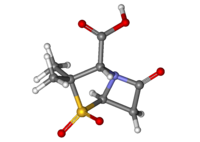|
Sulbactam
Sulbactam is a β-lactamase inhibitor. This drug is given in combination with β-lactam antibiotics to inhibit β-lactamase, an enzyme produced by bacteria that destroys the antibiotics.[1] It was patented in 1977 and approved for medical use in 1986.[2] Medical usesThe combination ampicillin/sulbactam (Unasyn) is available in the United States.[3] The combination cefoperazone/sulbactam (Sulperazon) is available in many countries but not in the United States.[4] The co-packaged combination sulbactam/durlobactam was approved for medical use in the United States in May 2023.[5] MechanismSulbactam is primarily used as a suicide inhibitor of β-lactamase, shielding more potent beta-lactams such as ampicillin.[6] Sulbactam itself contains a beta-lactam ring, and has weak antibacterial activity by inhibiting penicillin binding proteins (PBP) 1 and 3, but not 2.[7] References
Further reading
|
||||||||||||||||||||||||||||||||||||||||||||||||||||||||||||||||
Portal di Ensiklopedia Dunia

